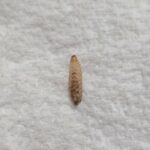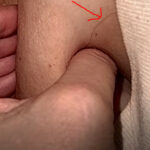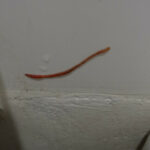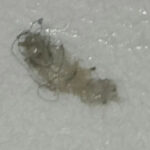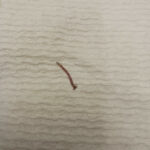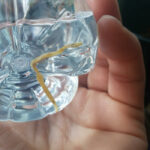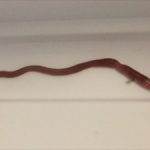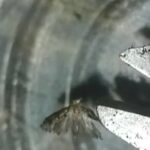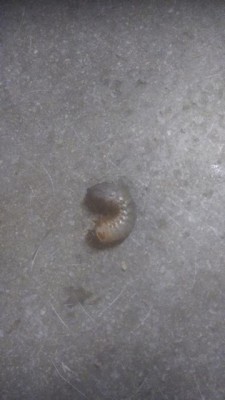
A reader would like help identifying what the worms she’s finding on her basement floor are. From the picture provided, we think that this is a lawn grub, possibly the larva of a June Bug or Masked Chafer Beetle, (Cyclocephala) which are members of the scarab family.
The Masked Chafer Beetle larva is a white grub with a dark stripe on its back with a brown head capsule and legs. When full grown, white grubs are about 1 inch (2.5 cm) long grubs and if our reader stretched one out, she’d find it has irregularly arranged spines on the underside of the last body segment (raster). They are commonly found curled in the C shape and are considered agricultural pests, in part because they really enjoy eating the roots under new turf and can kill lawn installations pretty handily. June bugs also attack the roots of lawns and farm crops.
Typically cyclocephala grubs operate a few inches below the soil surface, but burrow deeper (up to 8 inches in northernmost areas) before winter arrives. We don’t know where our reader lives, but if it’s autumn, there’s a chance that the larvae are headed deeper for the winter and may be coming into her basement over the foundation or (less likely) up through a drain or drain tile.
If our reader recently had a landscape installed, she may want to consult with her landscaper. The die-off of a new lawn over the winter might not just be due to cold weather. Avoiding overwatering in the summer months can help dry up eggs and larvae to prevent them from exceeding the 5-10 grubs per square foot generally considered safe for lawns and plantings.
Masked Chafers appear as ½ inch long brown beetles in late May, June and July and are active one or two months, and so are sometimes mistaken for their cousins, the June Bug (phyllophaga), which emerge at the same time but have a three year life cycle. Lawn grubs are often called white grubs, and while in this photo the worm looks more gray, it may be that this worm-like grub is a June Bug and has been developing its brown shell inside that larva for more than one season.
If our reader isn’t a fan of beetle larvae overwintering in her basement, she can eliminate the grubs when she finds them by tossing them into sudsy water. Some grubs in the lawn are ok, but too many chewing on the tender roots of the grass, and she’ll be able to pick up the turf like a blanket.
All About Worms is always free, always reader-supported. Your tips via CashApp, Venmo, or Paypal are appreciated! Receipts will come from ISIPP Publishing.
You might also find these guys interesting!




